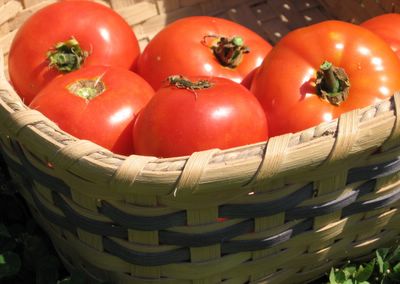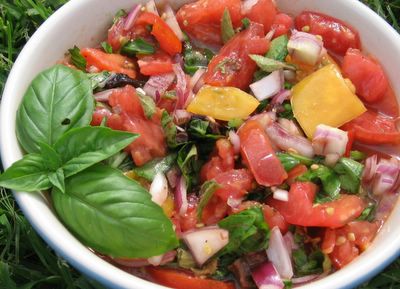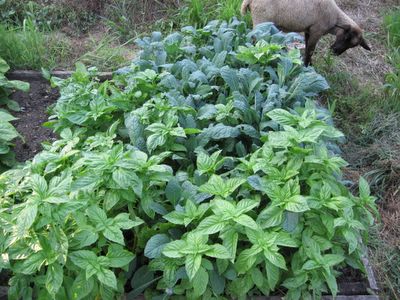Striped blister beetles on Straight 'N' Narrow bean leaves
June 2011 update: The other day I saw my first blister beetle of the year.
Ick. Our last few springs have been wetter than normal, and this has apparently kept the blister beetles from appearing in their usual droves
(hooray!).
If they start destroying the garden this year, I'll be liberally dousing them and the plants they're attacking with
food grade diatomaceous earth. This amazing stuff is 100% natural and organic and very safe.
We buy
this brand in economical 50-pound bags and use it all over the farm: we feed it to our livestock as a natural wormer and wellness supplement, dust the dogs with it to help with fleas and ticks, sprinkle it in water troughs to keep algae from forming, and have even started taking small daily doses ourselves (up to 1 Tablespoon, mixed in water or juice), as it's supposed to help with everything from joint pain to detoxification.
Food grade diatomaceous earth will last indefinitely (keep it dry) and can be used to combat all sorts of garden pests, including both hard-bodied (like sow bugs) and soft-bodied (like slugs and cabbage worms). Apparently it's also an excellent way to naturally kill bed bugs. It will not harm earthworms, but avoid sprinkling it directly on flower blooms, as it can kill beneficial pollinators.
Realization Of The Day:
The blister beetles have arrived. What to do?
If you don't know what these horrid little creatures are, please take a moment right now to feel very, very grateful. If you are all too familiar with them and their treacherous acts of decimation in the battlefield we foolishly call our gardens, then you have my sympathy. And if the blister beetles have not declared war on you yet this year, right now you're probably taking a moment to pray to whatever or whomever it is you pray to about these kinds of things. Me? I forgot to pray.
Blister beetles devouring my Swiss chard
Last year I happened to mention blister beetles on a
Farmgirl Fare post about, of all things,
chocolate cake. Okay, it was about farm emergencies in general, which is why the blister beetles came up.
Anyway, a reader named Emily left me the following comment:
"Since you mentioned blister beetles, could I ask how you deal with them? We have tomato plants in our backyard garden (in Kansas), and those nasty things wiped out an entire plant in one day!
We had never heard of them before, but our extension office identified them, solving the mystery of what happened to the plant as well as my poor husband's leg. Yikes, those blisters are vicious. Any advice you have would be most appreciated!"
And this was my reply:
I was so sorry to hear about your blister beetle invasion. You're right; they are vicious—and ravenous. They can destroy your entire garden in a couple of days.
For those fortunate readers who are not familiar with blister beetles, here is a little background information on them, taken from one of my very favorite books,
Organic Plant Protection, published by Rodale Press:
"The black blister beetle, also known as the Yankee bug and just plain 'blister beetle'. . . is a fairly long (up to 3/4") and slender beetle, with soft, flexible wing covers. The entire body is black or dark gray, and the covers may be marked with white stripes or margins.
Another species, the margined blister beetle, is distinguished by a narrow gray or yellow margin on the covers. Blister beetles are very active, and frequently appear in large numbers in the latter part of June and through July.
Handpicking is effective in controlling this pest, but you should protect your hands with gloves, as the beetles discharge a caustic fluid that is harmful to the skin. Some growers achieve control by dusting with equal parts lime and flour. This should be done at the warmest time of the day.
Blister beetles are usually found in swarms or colonies feeding on the blossoms and foliage of any of a number of garden and field crops—vegetables, vines, trees, and flowers."
We have both species mentioned here—the black/grey and the lighter striped ones. Last year both were out in force, and it was terrible. What they don't completely devour, they ruin with their icky black droppings.
I didn't know about that lime/flour solution until reading it just now. It sounds interesting. I would start with that as it is totally safe. Look for lime at a feed/farm supply store or nursery or garden center; it's very inexpensive.
I have read various other 'folk tale' remedies—like that they won't cross wide, empty spaces so you should either leave wide rows between plantings or once they have invaded, clear out the surrounding weeds, grass, plants, etc.
I've even read about people yelling at them to scare them away. Who knows. When I'm desperate, I'll try some pretty crazy sounding things myself.
I've never gone the hand-picking route, as there were always way too many of them—hundreds and hundreds last year. They also run fast! But that would be your best bet if you only have a few to contend with. I hope this helps. Good luck!
She came back and said:
"Thank you kindly for the information! Those terrors seem to be gone for now, but we'll know what to do next time. We thought we had gotten rid of them once, but they showed up a second time. It's good to know some natural remedies to try. Much appreciated!"
Bean and chard bed that has been hit the hardest (taken yesterday afternoon)
I saw two blister beetles in the garden yesterday morning. By the afternoon the troops had arrived and they were in full munching mode, happily making dirty lace of that poor, struggling Fordhook Giant Swiss Chard that had up to this point been eaten down to practically nothing by deer and then attacked by worms.
I snapped some photos, started getting depressed, and readied myself for total decimation by morning. A quick garden tour this morning assured me that the blister beetles were showing no signs of having filled up their small but seemingly bottomless bellies—I suppose because they immediately empty them with all that black yuck.
Attacked chard sprinkled with flour/lime mixture
I searched through
Farmgirl Fare, located the above information, and decided that I had nothing to lose with the flour/lime dusting suggestion. I used all-purpose flour and limestone ('granular calcium carbonate for livestock and poultry') that I bought two years ago in a 50-pound bag at the farm supply store for under two dollars (to add to the water of the two bottle lambs I had at the time to help control scours and some other stuff).
Since it was 95 degrees F in the shade, I figured this qualified as 'the warmest time of the day' and simply sprinkled the mixture all over the plants and the surrounding soil.
I checked back later and only saw a few blister beetles, but there also weren't any in evidence on the bean plants they had been all over earlier. I wondered if they were all simply taking a siesta. I also wondered if this was such a wise idea. If I succeeded in getting them to vacate my already ruined chard, what would they attack next?
What's left of the Oriole Orange chard.
Another round of surveillance just moments ago revealed a few on the chard, a few on the Nero di Toscana cabbage in the adjacent raised bed (which had already been half devoured over the past few days by Cary and cabbage worms), and the scary remains of what had once been Oriole Orange Chard that I had missed seeing being attacked earlier.
In between these checks I launched a fairly exhaustive search on the internet for any helpful information in beating the blister beetles. I didn't find much. The highlight was definitely this incredibly significant and yet ridiculously obvious statement I found on a
Texas Cooperative Extension site: Mouthparts are for chewing. At least it made me laugh.
Here's some more information about blister beetles I came across:
--The 'caustic fluid' blister beetles discharge/secrete is called cantharadin and is toxic to people and animals.
--Larval stages feed on grasshopper eggs or are predaceous and are thus considered to be beneficial, although a few species feed in nests of solitary bees.
--I read more than once that blister beetles supposedly do little or no damage to backyard gardens (Ha. Ha ha ha ha ha. Oh please.).
--Those sites that did admit to the terrible destruction they are capable of usually had nothing helpful to tell gardeners to do
except to practice "diligent hand picking" while of course always wearing gloves to protect your skin from the cantharadin. Or you can simply knock the beetles directly into a can of soapy water.
--A
thread on the Garden Clinic Forum on
Gardenweb.com was started by a woman in Southwest Missouri who said, "I am having the same problem with blister beetles.I had never seen them before. They have almost completely devoured my potatoes and were starting on a tomato plant. I've sprayed several times with rotenone. It kills them but more just keep on coming." Nobody was able to offer her much help.
In years past, I've simply admitted defeat as soon as the battles with the blister beetles began. Their surprise attacks come without warning (is that redundant?) and are short, messy, and full of horrific damage. But they usually seem to disappear just as quickly as they arrived, and I have never had them decimate my entire garden.
Once again, I won't pull up either of the patches of chard (even the Oriole Orange that is simply painful to look at right now), the Nero di Toscana cabbage, and anything else they decide to devour in the next day or two. At least some of these plants should recover and reward me with edible bounty once the blister beetles are only a hazy nightmare.
If you have any experience with blister beetles, especially if you've figured out a way to win the war with them, I (and probably many other frustrated gardeners) would love to hear about it.
But right now I'm forcing the blister beetles out of my mind so I can concentrate on cooking up the beautiful beets I harvested earlier to go with the garlic and herb encrusted leg of lamb that I just pulled from the oven.
And for the person in this household who doesn't care for beets (yippee, all for me!) there will be crispy pan-fried new potatoes (in homemade lard), along with salads for both of us made with any greens I can scrounge up in the garden and topped with slices of rosy red tomatoes that will no doubt still be warm from the sun.
Oh, the dragonflies arrived in swarms yesterday, too. That almost made up for the blister beetles. They're glorious.
©
FarmgirlFare.com

































